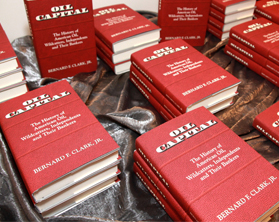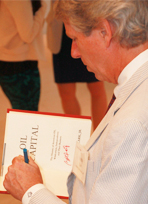© 2016 The Texas Lawbook.
By Buddy Clark of Haynes and Boone
(July 6) – “Oil and gas producers are always out of money. They just inhale capital,” observed Texas oilman Joe Bridges.
Put simply, Joe’s statement represents the underlying theme in Oil Capital: The History of American Oil, Wildcatters, Independents and Their Bankers. The book is my five-year literary effort to chronicle the origins and development of oil and gas independents and their insatiable need for bankers.
I started working on Oil Capital while researching for a presentation on current trends in oil and gas finance. Looking over lawyer and banker presentations from the 1950s through the current era, the similarity of their comments was striking. Producers’ access to capital has always been their lifeblood. However, in my research I was unable to find any analysis of how this relationship between the capital providers and producers evolved and developed, reacting to influences by the markets, regulations and world events.

Given the early-day, Wild West nature of oil production, finding any bankers willing to part with their depositors’ hard-earned money was tougher than discovering oil.
Back then, producer demands for capital were answered by individual investors interested in get-rich schemes – many of which were fraudulent or idle dreams of promoters looking for a fast buck.
Those producers who did find oil often found too much, flooding local markets with flush production that drove prices so low the producers were bankrupted by their success. The industry finally settled down. The dynamic and destructive boom-and-bust cycles caused by each new gusher eventually were tamed following the discovery of the East Texas Field in 1930. The East Texas Field’s production was so prodigious, so overwhelming, that even dyed-in-the-wool independents agreed that some form of governmental intervention and market regulation was needed to save them from themselves.
By the mid-1930s, following the introduction of regulations approved by the courts, the partnership between producer and energy banker began in earnest. Pioneering oil bankers were typically local bankers who understood the producers and were able to assess the risks associated with lending against collateral buried deep underground that could be neither seen nor directly measured. A beneficial relationship between banks and producers developed over time, adjusting with industry changes, along with national and world events.
I have been practicing in Houston concentrating on oil and gas finance law since the early 1980s, so as part of my research I was able to interview many senior energy bankers and oil executives I have worked with over the years. To my delight, they were very helpful and appreciative that this side of oil and gas history was finally being recorded.
One of my sources was Joe Bridges, who so elegantly summarized the Oil Capital theme. Like many of the personalities in the book, Joe’s rich background provided invaluable perspective on industry cycles and trends. Joe grew up in the West Texas Permian Basin, earned an engineering degree from the University of Texas and went to work in oil and gas fields. He moved on to become a First City energy banker in Houston, then a chief financial officer for a public oil and gas company before founding his own oil and gas companies.
 As Bridges and others will tell you, the industry has weathered many boom-to-bust cycles since Colonel Drake’s initial discovery in Titusville, Pa. The narrative of Oil Capital follows these cycles and how the industry and bankers reacted to them.
As Bridges and others will tell you, the industry has weathered many boom-to-bust cycles since Colonel Drake’s initial discovery in Titusville, Pa. The narrative of Oil Capital follows these cycles and how the industry and bankers reacted to them.
Changes were caused by new discoveries, new technology, new regulations and world events, all of which affected market forces. Those forces manifested themselves in wild price swings for the oil production that served both as the banker’s collateral and the producer’s salvation.
The most dramatic cycle that tested the producer-banker relationship was the downturn in the 1980s. It came on the heels of a late 1970s price spike caused by global changes in oil markets wrought by turmoil in the Middle East and the rise of OPEC.
When the price of oil began to fall in the mid-1980s, a lot of producers and energy banks were caught in a maelstrom that changed the landscape of both industries. Nine of the ten largest banks in Texas failed. Large banks in other regions of the United States were also adversely affected. Producers trying to pay back loans taken out in 1981 when oil was $31 per barrel could not pay back the debt five years later with $12-per-barrel oil.
When I started to research in 2011, the industry was recovering from the 2008 price collapse that saw prices fall from $145 per barrel in July down to $30 by year end. But by 2011, prices were around $100 per barrel and ready capital for producers was available for the asking.
By 2014, I was finishing my research and ready to finalize the book. At that point, the story was ending on a positive note, a true American success story. “Peak Oil” had been debunked. Independent producers had reinvented the industry by producing new unconventional resources. The long and steady decline in domestic production had turned around to the point that the U.S. was exceeding levels not seen since the 1970s. That was until OPEC delivered a turkey to the industry on Thanksgiving Day.
 Following OPEC’s announcement, as producers sat down with their families sometime between the stuffed turkey and the pumpkin pie, the price of West Texas Intermediate dropped more than ten percent. Oil would lose almost 30 percent of its value in less than two months. Bankers spent the next months reexamining their producers’ loans, producers scrubbed and slashed their capital 2015 budgets, and I decided I would have to add another chapter to the continuing history of oil capital.
Following OPEC’s announcement, as producers sat down with their families sometime between the stuffed turkey and the pumpkin pie, the price of West Texas Intermediate dropped more than ten percent. Oil would lose almost 30 percent of its value in less than two months. Bankers spent the next months reexamining their producers’ loans, producers scrubbed and slashed their capital 2015 budgets, and I decided I would have to add another chapter to the continuing history of oil capital.
I did not know when I began my research in 2011 that by the time I was finished the industry would undergo yet another price collapse, one much more damaging than the short 2009-2010 downturn.
Our current industry downturn is much more like the 1980s decade of destruction. As of June 2016, in the 18 months since OPEC delivered its Thanksgiving surprise, 70 North American producers have filed bankruptcy with aggregate debt of over $52 billion. And more producers are likely to follow.
The story of Oil Capital, as told from the follow-the-money perspective, is interesting as a historical narrative. More importantly, understanding the history of this facet of the oil industry helps the reader focus on and better understand today’s current downturn cycle.
Knowing the impact of prior downturns on producer access to capital gives us guidance for what to expect in the near- to mid-term. As with prior downturns there will be jobs lost, investments destroyed and companies will disappear or be swallowed up by healthier peers.
But if history is a guide, out of such destruction there will arise new companies, new innovations and, importantly, new sources of capital – the lifeblood of oil and gas producers.
While the producers, bankers and other investors may change over time, the rocks stay the same. The hydrocarbons formed millennia ago remain waiting to be produced by new producers with new technology, and financed by new sources of capital.
Buddy Clark is a partner at Haynes and Boone in Houston, where he leads the Energy Practice Group. He represents banks, private capital providers and producers in secured and unsecured credit transactions and equity investments. Clark’s new book is “Oil Capital, The History of American Oil, Wildcatters, Independents and Their Bankers.”
© 2016 The Texas Lawbook. Content of The Texas Lawbook is controlled and protected by specific licensing agreements with our subscribers and under federal copyright laws. Any distribution of this content without the consent of The Texas Lawbook is prohibited.
If you see any inaccuracy in any article in The Texas Lawbook, please contact us. Our goal is content that is 100% true and accurate. Thank you.
